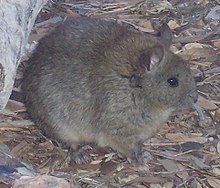Greater stick-nest rat
| Greater stick-nest rat | |
|---|---|

| |
| Scientific classification | |
| Domain: | Eukaryota |
| Kingdom: | Animalia |
| Phylum: | Chordata |
| Class: | Mammalia |
| Order: | Rodentia |
| Family: | Muridae |
| Genus: | Leporillus |
| Species: | L. conditor
|
| Binomial name | |
| Leporillus conditor (Sturt, 1848)
| |
The greater stick-nest rat, house-building rat (Leporillus conditor) is a species of rodent in the family Muridae.
It is found only in Australia on the Franklin Islands and St Peter Island in the Nuyts Archipelago, Reevesby Island, Salutation Island, Faure Island and Heirisson Prong, and a fenced off area at Roxby Downs in South Australia.[2] It was formerly widespread in semi-arid habitat on the mainland,[3] where the soils were shallow with calcereous underlying strata.[4]
It measures 32 centimetres (13 in) to 44 cm (17 in) in total length, weighing 180 grams (6 oz) to 450 g (16 oz).[5] Its natural habitat is dry savanna, with perennial shrubland, especially of succulent and semi-succulent plant species including the chenopod and pig-face genera.[6]
References
- ^ Template:IUCN2008 Listed as Vulnerable(VU D2 v3.1)
- ^ http://www.arkive.org/greater-stick-nest-rat/leporillus-conditor/
- ^ Ellis, M. (1995). A discussion of the large extinct rodents of Mootwingee National Park, western New South Wales. Australian Zoologist. 30:1-4.
- ^ Josephine Flood (2004) Archaeology of the Dreamtime, J.B Publishing, Marleston p. 206 ISBN 1-876622-50-4
- ^ http://www.arkive.org/greater-stick-nest-rat/leporillus-conditor/
- ^ "The Action Plan for Australian Rodents". Department of the Environment. 1 April 1995. Retrieved 24 December 2015.
- Musser, G.G.; Carleton, M.D. (2005). "Superfamily Muroidea". In Wilson, D.E.; Reeder, D.M (eds.). Mammal Species of the World: A Taxonomic and Geographic Reference (3rd ed.). Johns Hopkins University Press. pp. 894–1531. ISBN 978-0-8018-8221-0. OCLC 62265494.

